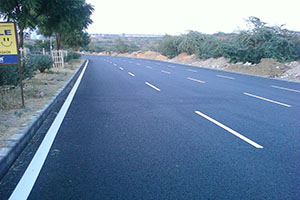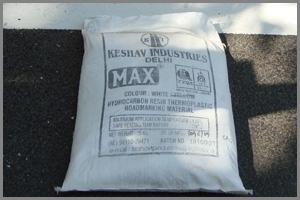
Thermoplastic Road Marking Material


Material
- 1. Thermoplastic Material
Max brand thermoplastics material is manufactured by Keshav Industries 32, Tarun Vihar, Sector-13, Rohini, New Delhi-85. This consists of aggregate, pigment, resin and glass beads as per Technical specification Bs 3262, or most specification of proportion of constituents as per morth 803.4
Percentage By weight
| S.No. | Components | White | Yellow |
|---|---|---|---|
| 1 | Binder | 18% min. | 18% min. |
| 2 | Glass Beads | 30-40% | 30-40% |
| 3 | Titanium Dioxide | 10% | |
| 4 | Calcium Carbonate | 42% | As per manufacture |
Properties of Max Thermoplastic Material in comparison to specification laid down by morth
| Particulars | White as per morth | Max Brand | Yellow as per morth | Max brand |
|---|---|---|---|---|
| Day light Luminance at (45°C) | 65% min | 72% | 50% | 60% |
| Drying Time | Not more than 15 minute | 7 minute | Not more than 15 min | 8 min |
| Cracking Resistant at Low Temp | Shall show no cracks pass on application to concrete block | Pass | Shall show no pass crack on application to concrete block | Pass |
| Softening Point | 102.5±9.5°C | 103.4°C | 102.5±9.5°C | 97.0°C |
| Flow Resistant | Not more than 25% | 7% | Not more than 25% | 8% |
Glass Beads
Class A beads are those which are a constituent of basic thermoplastic compound and class B beads are those which are to be sprayed on the surface. Both confirm to the Technical Specification of BS 6088.
1. Machine
The work will be carried out by fully automatic, semi-automatic, or manual applicator machine. One priheater for preparation of material will also be used to speed up the work if necessary
2. Preparation Of Material
Thermoplastic powder is put into the container of machine and it is heated. The material is mixed uniformly by operation of the agitator in the container. The thermostat is adjusted to a temperature of 155-165 degree centigrade. The material is added to the container to its full capacity and melted till it achieves smooth consistency. The molten material will be used expeditiously. The thermoplastics material will also be prepared in premeltor and transformed into the container of machine.
3. Application
- The marking will be done by fully automatic machine or semi automatic machine or, approved manual applicator machine will be used.
- The Thermoplastic material will be applied hot by screeding or extrusion process.
- All surfaces to be marked will be thoroughly cleaned of all dust, dirt grease, oil and all other foreign matter before application of the marking.
- The lines through which the marking is to be done will pre marked.
- The desired setting for the marking (broken lines continuous lines etc.) will be made in the control panel of automatic machine, The glass beads for super imposition on the marking will also be put into its container ad setting adjust at 250 grams per sq. meter
- The molten material will be allowed to pass into the screed box of the desired size (10cms, 15cms, Etc). The screed box will be adjusted for thickness of 2.5mm the screed box will also be heated using the built in heaters.
- The machine will be driven through the pre marked line and the screed box shutter is opened which will allow the material to flow to the surface.
4. Drying and Opening To Traffic
Traffic cones will be provided to cover the marking form vehicular traffic. After 15 minutes of drying, road can be opened for traffic.
Max Thermoplastic Road Marking Materia
Method Of Storing, Handling, Mixing And Applying
The material should be kept in covered dry space and should be used within 12 months time. The material shall be melted in a heater fitted with mechanical stirrer to prevent local overheating. The material shall be laid over sad mud or similar extraneous matter. The surface temperature should be above 10 degree C.On concrete surface a track coat shall be used before the application. The application temperature should be 160 degree C to 180 degree C.
The maximum temperature should not exceed 200 degree. Color change indicates the material is over heated.
Material should not be applied if moisture is present on the surface. If any moisture content is suspected on the road surface it shall be warmed carefully by a gas heater so that the surface is dry when the material is laid.
Physical contact with hot thermoplastic should be avoided. Operating personnel should wear proactive asbestos or any other heat resistant gloves. In case one accidentally gets in contact with hot material use ice water to cool affected areas immediately.
